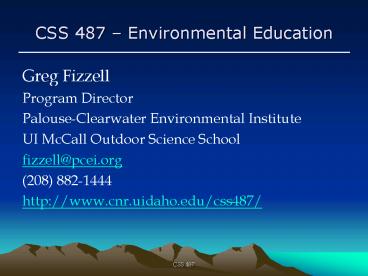CSS 487 Environmental Education - PowerPoint PPT Presentation
1 / 14
Title:
CSS 487 Environmental Education
Description:
... collectively toward solutions of current problems and the prevention of ... are connected through the medium of the environment and environmental issues. ... – PowerPoint PPT presentation
Number of Views:32
Avg rating:3.0/5.0
Title: CSS 487 Environmental Education
1
CSS 487 Environmental Education
- Greg Fizzell
- Program Director
- Palouse-Clearwater Environmental Institute
- UI McCall Outdoor Science School
- fizzell_at_pcei.org
- (208) 882-1444
- http//www.cnr.uidaho.edu/css487/
2
Environmental Education
- A Vision for the Future
From Excellence in Environmental Education North
American Association for Environmental Education
(NAAEE)
3
Fundamental Beliefs
- Humans can live compatibly with nature and act
equitably toward each other. - People can make informed decisions that consider
future generations.
4
Two Founding Documents
- The Belgrade Charter (1976)
- United Nations Conference
- Goal Statement
- The Tbilisi Declaration (1978)
- Worlds first intergovernmental conference on
environmental education (EE) - Built upon the Belgrade Charter
- Three Broad Goals for EE
5
The Belgrade Charter (1976)
- Goal Statement for Environmental Education
- The goal of environmental education is to
develop a world population that is aware of, and
concerned about, the environment and its
associated problems, and which has the knowledge,
skills, attitudes, motivations, and commitment to
work individually and collectively toward
solutions of current problems and the prevention
of new ones.
6
The Tbilisi Declaration (1978)
- Three Broad Goals
- To foster clear awareness of, and concern about,
economic, social, political and ecological
interdependence in urban and rural areas - To provide every person with opportunities to
acquire the knowledge, values, attitudes,
commitment and skills needed to protect and
improve the environment - To create new patterns of behavior of
individuals, groups and society as a whole
towards the environment.
7
In a Phrase
- A Need for Environmental Literacy
- predicated on the belief that if we educate our
citizens so they are capable of making quality
decisions, they will do so when the time comes.
8
Essential Underpinnings of EE
- Core of Key Principles
- Systems
- Interdependence
- Importance of where one lives
- Integration and infusion
- Roots in the real world
- Lifelong learning
9
Essential Underpinnings of EE
- Systems help make sense of a large and complex
world. The whole is understood only by
understanding the relationships and interactions
among the parts. - Interdependence Human well being is inextricably
bound with environmental quality
10
Essential Underpinnings of EE
- The importance of where one lives Beginning
close to home, learners forge connections with,
explore, and understand their immediate
surroundings. - Integration and infusion Disciplines from the
natural sciences to the social sciences to the
humanities are connected through the medium of
the environment and environmental issues.
11
Essential Underpinnings of EE
- Roots in the Real World Learners develop
knowledge and skills through direct experience
with the environment, environmental issues, and
society. - Lifelong learning Critical and creative
thinking, decision making, and communication, as
well as collaborative learning are emphasized.
12
General Principles that Guide EE Instruction
- Learner is an active participant
- Guided by learners interests
- Opportunities for independent thinking and
effective responsible action - Engage in collaborative, group work
13
General Principles that Guide EE Instruction
- Strong emphasis on developing communication
skills - Balanced approach to instruction
14
General Principles that Guide EE Instruction
- Focus on immediate surroundings
- Early and continuing opportunities to explore
their environment































